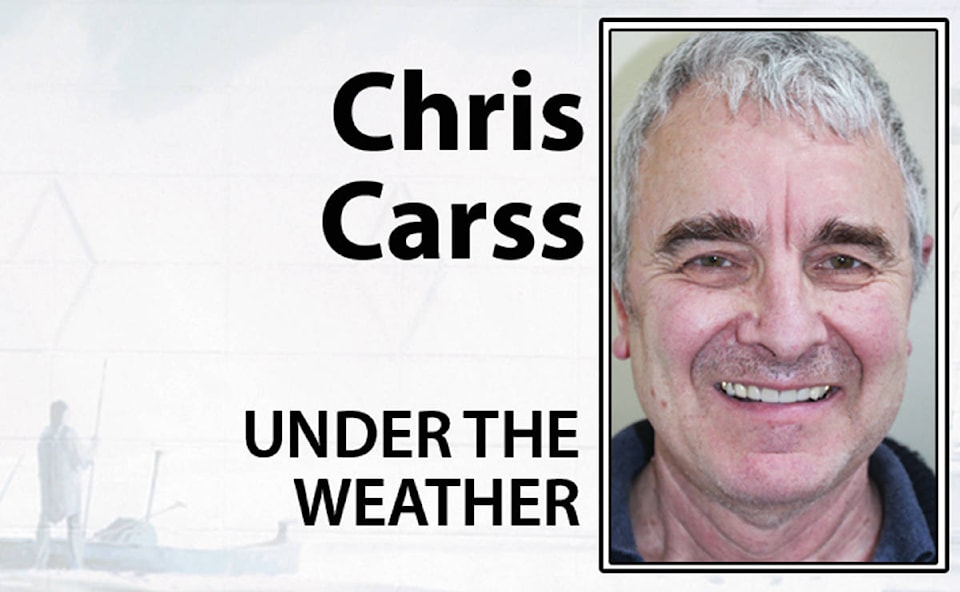A weak El Nino ocean current in the Pacific Ocean appears to have lost its grip on Vancouver Island. As a result, the Chemainus Valley is losing its early taste of spring to a fresh outbreak of Arctic Air.
However, there’s another element of winter that we might also have to contend with in the coming weeks, and that’s the possibility of another powerful wind storm like the one we had just before Christmas. Despite the current spell of colder weather, global warming is continuing as a longer term trend, and these powerful storms are becoming more frequent and more destructive as a result.
This has major implications for Vancouver Island and exposed coastline areas of the B.C. mainland. As our planet continues to heat up, we can look forward to more frequent floods, more downed trees, more damaged infrastructure, and of course, longer and more frequent power failures.
I think most of us agree that BC Hydro did the best job it could to restore power to the Island after last December’s brutal wind storm. But did the utility do as much as possible ahead of time to minimize the damage we know these storms can inflict?
There’s an old (pre-metric) saying that an ounce of prevention is worth a pound of cure, and when I travel around the Cowichan and Chemainus Valleys, I see areas where the overhead power lines are well clear of trees and other areas where they are not.
In Chemainus, the lines appear to be a reasonable distance from surrounding trees, but in parts of Saltair, it’s a whole different ball of wax. Old Victoria Road in that community has power lines absolutely buried in trees that are almost never pruned. It seems from casual observation the power lines in the municipalities are better maintained than they are in the more rural electoral areas.
Much of Vancouver Island is governed by a tangled web of governments and agencies that have overlapping territories and responsibilities. This makes it easy for everyone in charge to pass the buck to everyone else. Where the power lines are concerned, BC Hydro needs to either maintain all the lines on its own, or issue clear orders to others to have trees pruned or even removed if they pose a threat to the overhead power lines.
I can already hear screams of protest from environmentalists who think the welfare of trees should be put ahead of the welfare of our shaky power grid, and they may have a point. This brings us to another solution to the problem; bury all major power lines on stormy Vancouver Island rather than just those that have been installed over the past few decades.
Except now I can hear screams of protest from BC Hydro’s bean counters who maintain burying the older lines would cost too much. To them I ask, how much does it cost the Island economy and the quality of life for the Island’s residents to carry on forever with an antiquated system that puts the ‘cure’ ahead of prevention. Every time a major storm hits, we throw the hydro poles back up as fast as we can and then leave them to be blown down again another day.
Imagine what it would be like if we delivered our water and natural gas the same way as we deliver our hydro power to most households, in overhead pipes! Despite the additional costs of burying our natural gas lines, it manages to be a cheaper source of power than electricity.
Some people oppose buried power lines with the claim a break in the line would be much harder to find if it were buried. That might be theoretically true, but our experience with water and natural gas suggests such underground breaks are far less common than our power failures, and when they occasionally occur, the locations of the breaks are usually located quite fast by experienced crews.
This last argument against burying our power lines is totally scuttled by the fact BC Hydro is now burying its lines in newer neighbourhoods. So far, the power failures in these areas are caused mainly by downed overhead lines nearby, not by the buried lines.
This problem will not be solved quickly. If BC Hydro were to start burying its main intercity power lines at an affordable rate of speed, it would likely take at least 10 years to do the job. That’s a long time, but at least the job would eventually get done. With a bit of luck, the project might be completed just in time to beat the mega-storms that may await us as our planet continues to heat up.
(Chris Carss is a Chemainus resident and longtime weather observer/recorder).
